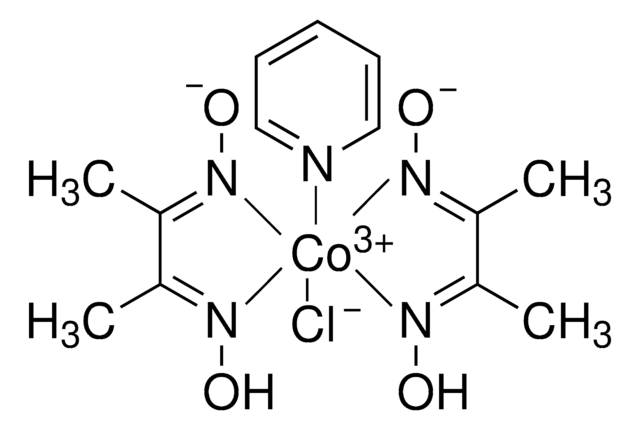Kluczowe dokumenty
769495
Cobalt(II) chloride hexahydrate
≥97%
Synonim(y):
Cobaltous chloride hexahydrate
About This Item
Polecane produkty
klasa czystości
for analytical purposes
Poziom jakości
ciśnienie pary
40 mmHg ( 0 °C)
Próba
≥97%
97.0-102.0% (KT)
Formularz
solid
ślady anionów
nitrate (NO3-): ≤0.01%
sulfate (SO42-): ≤0.007%
ślady kationów
Fe: ≤0.005%
Ni: ≤0.15%
Pb: ≤0.002%
Zn: ≤0.05%
ciąg SMILES
O.O.O.O.O.O.Cl[Co]Cl
InChI
1S/2ClH.Co.6H2O/h2*1H;;6*1H2/q;;+2;;;;;;/p-2
Klucz InChI
GFHNAMRJFCEERV-UHFFFAOYSA-L
Szukasz podobnych produktów? Odwiedź Przewodnik dotyczący porównywania produktów
Powiązane kategorie
Opis ogólny
Zastosowanie
- Dodatek do warstwy transportu elektronów (ETL) w perowskitowych ogniwach słonecznych w celu poprawy ich wydajności, w szczególności poprzez zmniejszenie strat energii i zwiększenie napięcia obwodu otwartego.
- Źródło kobaltu do domieszkowania nanostruktur ZnO. Włączenie jonów kobaltu do matrycy ZnO ma kluczowe znaczenie dla modyfikacji jego właściwości elektronicznych i optycznych.
- Prekursor do modyfikacji mikrosfer węglowych na bazie metaloorganicznego szkieletu kobaltowego (Co-MOF) do zastosowania jako materiał anodowy w bateriach litowo-jonowych.
Komentarz do analizy
Hasło ostrzegawcze
Danger
Zwroty wskazujące rodzaj zagrożenia
Zwroty wskazujące środki ostrożności
Klasyfikacja zagrożeń
Acute Tox. 4 Oral - Aquatic Acute 1 - Aquatic Chronic 1 - Carc. 1B Inhalation - Eye Dam. 1 - Muta. 2 - Repr. 1B - Resp. Sens. 1 - Skin Sens. 1
Kod klasy składowania
6.1D - Non-combustible acute toxic Cat.3 / toxic hazardous materials or hazardous materials causing chronic effects
Klasa zagrożenia wodnego (WGK)
WGK 3
Temperatura zapłonu (°F)
Not applicable
Temperatura zapłonu (°C)
Not applicable
Wykazy regulacyjne
Wykazy regulacyjne dotyczą głównie produktów chemicznych. Można w nich podawać ograniczoną liczbę informacji na temat produktów niechemicznych. Brak wpisu oznacza, że żaden ze składników nie znajduje się w wykazie. Użytkownik odpowiada za zagwarantowanie bezpiecznego i zgodnego z prawem stosowania produktu.
EU REACH SVHC Candidate List
EU REACH Annex XVII (Restriction List)
Wybierz jedną z najnowszych wersji:
Masz już ten produkt?
Dokumenty związane z niedawno zakupionymi produktami zostały zamieszczone w Bibliotece dokumentów.
Klienci oglądali również te produkty
Global Trade Item Number
| SKU | GTIN |
|---|---|
| 769495-25G | |
| 769495-100G | 4061833315019 |
Nasz zespół naukowców ma doświadczenie we wszystkich obszarach badań, w tym w naukach przyrodniczych, materiałoznawstwie, syntezie chemicznej, chromatografii, analityce i wielu innych dziedzinach.
Skontaktuj się z zespołem ds. pomocy technicznej










